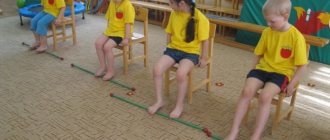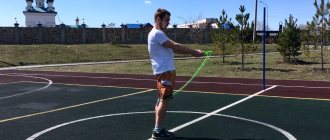Many of us remember that rope climbing was one of the practices in physical education classes. But today, not every adult, much less a child, masters this generally necessary climbing technique. But in vain. Such climbing is not only a fascinating activity that brings positive emotions, but also a useful practice: it trains agility, physical strength, develops the vestibular apparatus and general coordination of movements. Today we are in a hurry to tell you how to learn to climb a rope. Let's start with preparation.
Preparatory exercises
Before you learn how to climb a rope from scratch, you need to prepare your body for a new load:
- First of all, strengthen your hands by exercising with a regular wrist expander.
- The following exercise will help strengthen the muscles of your arms and legs: hang on a rope while holding it with your legs crossed below the knees. During the exercise, you need to alternately move your arms up and down.
- Grasp the rope with your hands as high as possible and hang on it. Don't help yourself with your feet. Your goal is to hang as long as possible. Once you can handle this exercise with ease, try doing pull-ups without using your legs.
Typical beginner mistakes
There are a number of mistakes that novice athletes make at the initial stage:
- Incorrect hand placement. There is no need to spread your elbows, otherwise the load will fall on your elbows and back instead of your shoulders.
- Use of gloves. Gloves will not protect your hands from calluses, but will weaken your grip, which will increase the risk of slipping and injury.
- Incorrect leg position. The rope is weakly fixed, which leads either to slipping of the legs or increased load on the arms.
- Insufficiently high hand grip. The load on the arms and shoulder girdle is reduced. The rate of ascent decreases.
- Wrong descent. Beginners often slip or simply jump off. The first option threatens with abrasions or burns to the palms. Second, serious injuries from a fall.
Neglecting pre-treatment of hands - before the exercise, it is advisable to treat your hands with magnesium. This will improve the grip of your palms on the cable and prevent you from slipping while lifting.
Rope climbing techniques
If you are interested in how to learn how to climb a rope, then we will present you with three popular techniques that you can try yourself:
- "Caterpillar". While standing, hang from the rope. In this case, the latter must be grasped as high as possible. Bend your legs, crossing them so that you grab the rope between them. Extending your legs (but without removing the cross!), move your hands higher and squeeze the rope tightly. Repeat the steps as many times as necessary. To get back down, you need to do this: tightly grasp the rope with your legs crossed, bend over, lowering your arms lower. Then slide your feet lower along the rope and fix it with a cross.
- Fast way. Before you learn how to climb a rope using this technique, remember that it requires more effort, although it is fast. In the starting position, grab the rope so that one hand is as high as possible above your head, and the other is at chest level. Bend your legs, fixing the rope at their cross. Then switch your hands. Again, bend your legs, pinch the rope with them and repeat the action. You should move back like this: first of all, intercept the rope at the level of your stomach, and then lower your legs down.
- Force method. The most extreme one - you can learn it only after mastering the two previous techniques. The point of movement here is to simultaneously move your arms up (and down when descending), only indirectly helping yourself with your legs.
What are the benefits of rope climbing?
Climbing a rope (especially in a method without using legs), the athlete works a huge number of muscle groups (the latissimus, rhomboid and trapezius muscles of the back, rear deltoids, biceps and forearms), trains strength endurance and explosive power, and increases grip strength. The static load is also carried by the abdominal muscles and neck muscles. Our dexterity and coordination also increases, and a huge number of small stabilizer muscles are worked out, which are difficult to use when working with free weights or in exercise machines.
By working with our own body weight, we do not create an axial load on our spine, and also do not overload our joints and ligaments.
Climbing the rope gives us an excellent opportunity to work almost all the large muscle groups of our torso in a fairly short time - in just a few approaches, which is why this exercise has gained immense popularity in CrossFit.
In functional training, we perform climbing within complexes, which increases the effectiveness of our training and introduces the necessary variety. For people who are fond of martial arts, the skill of rope climbing will also be extremely useful - well-developed hands and forearms will allow you to more easily perform various throws and grabs, and will help you feel more comfortable and confident when fighting on the ground.
In addition to the above, hanging on a rope for a long time is a kind of isometric load on the arms, which will lead to microtraumas of your tendons, after the restoration of which you will feel a good increase in strength in pressing and pulling movements. But remember that as with any other exercise, all these benefits are only achievable with proper technique. Choose a technique with which you do not feel any discomfort, practice this movement until it becomes automatic and move on to studying more complex variations.
Advice from an expert
For those who are interested in learning how to climb a rope, we present advice from M. Bondi (Guinness Book of Records record holder in rope climbing):
- In the starting position, place your hands shoulder-width apart and bend your knees slightly.
- Depending on whether you are right-handed or left-handed, wrap one hand around the rope as high as you can.
- Prepare for the jerk by bracing your core and squeezing your shoulders.
- Pushing off the floor with the foot opposite your hand, make a sharp movement, as if you were punching someone in the gut.
- When jerking, your gaze should be directed upward so that with your second hand you catch not the air, but the rope.
- It is important to grab as high as possible. However, in the beginning you can also take small “steps” with your hands.
- In further progress along the rope, it is important to catch the rhythm: extend your arm - grab it - pull yourself up - make a new jerk.
- At first it will be difficult for you to rise on your hands alone - actively help yourself with your legs. Raising your knees, make a cross lock: you need to pass the rope under one foot and over the other. Now you can lean on this “step”, carefully moving your hands up.
- It's a big mistake to hang on a tightrope. Your hips should fit snugly against it.
- Don't swing your arms wide. They should be as close to the rope as possible.
- When you go down, under no circumstances slide down the rope, you will simply wear your palms down to the ground. You need to move, alternately moving your arms (and legs, if it’s hard for you to go down without them).
Waves with ropes[edit | edit code]
Ropes can also be used in a horizontal plane. Depending on the length, weight and thickness of the ropes, exercises with them will be aimed at developing endurance and/or strength. Technique Tips:
the legs are bent, the back is straight, the chest is protruded, the head is raised, the gaze is fixed at the horizon level.
Options:
wave-like movements with one or two hands - weak, medium or large amplitudes; side waves intersecting horizontally or performed with a reverse grip; and finally, side lifts (star). As your coordination improves, you can add legs.
Wave-like work with ropes allows you to train the endurance of the cardiovascular system in general in an original manner, as well as develop the strength of the back and arm muscles.
- Keep your legs slightly bent
- All of these exercises can be modified by moving your legs forward, backward, in 6-steps or lunges
- Control the position of your back, even if it is not directly loaded
- With both hands at the same time. Ordinary waves with different amplitudes
- Throwing ropes from one side to the other using a reverse grip. Cross waves with ropes
- Exercise "star" with ropes
Summary table of the different effects of rope exercises
| The cardiovascular system | Force | Coordination | Plank | |
| Regular waves | ** | ** | * | * |
| Weak amplitude | *** | * | ** | * |
| Large amplitude | ** | ** | ** | ** |
| With both hands at the same time | * | *** | * | ** |
| Reverse grip | * | ** | ** | *** |
| Horizontal crossing | * | * | *** | ** |
| Star | ** | * | *** | * |
Examples of rope training[edit | edit code]
Workout 1 - “Roller Coaster”
- 3 x 10 box jumps - 3 x 10 tuck jumps - 3 x 10 burpees
Perform in combination for 10 minutes: 20 seconds of regular rope waves - 20 meters of sprint (there/back 2x10 meters) - 10 burpees - 20 seconds of waves with both ropes with arms - 10 tuck jumps - 10 star burpees.
- 10 x 30 seconds of fast running - 30 seconds of slow running.
Workout 2 - Multiple Ends
Perform 6 approaches in a row as quickly as possible: 10 tuck jumps - 10 rope waves with two hands - 10 burpees - 10 rope waves with large amplitude - 400 meters run.
Workout 3 - SONIC WAVE
Make waves as quickly as possible for 10 seconds with a minute start for 10 minutes.
10 rope waves with two hands - 5 burpees - 50 meters sprint at maximum speed. Recovery 3 minutes. 10 approaches.
How to teach a child?
How can a girl or boy learn to climb a rope? You can prepare your child as follows:
- The first step is to teach the young athlete to simply hang on the rope for as long as possible.
- Next, lightly swing the rope over the mats - the baby should be able to hold on to it.
- The next stage is to invite the child to swing the rope himself using his body movements, without touching the floor or walls.
- The last preparatory stage will be training leg clamps - this is best done with a gymnastic stick or pole. The child must learn to perform the correct grip: one foot is adjacent to the sports equipment with its front part, the second goes around it with the inside, closing the cross.
Now you just need to turn to teaching a boy or girl climbing techniques.
Preparatory exercises and periodic training will help both adults and children to quickly learn how to climb a rope. It is important to move consistently from simple to complex, not to be lazy, work on mistakes and consolidate the result.
Crossfit complexes
The main method of rope climbing used by athletes from all over the world in CrossFit is without legs. There is, of course, a certain logic in this: the more complex the exercise, the more effective it is. It is this version of rope climbing that requires maximum concentration and dedication from the athlete, especially if it is necessary to perform it within the framework of complexes in an explosive manner and with a minimum rest interval. However, if your training does not imply consistently good results in climbing without legs, you can replace this method with one that you are better at.
Below are several complexes, by performing which you can check whether you are ready for truly difficult functional training. Extreme load on all muscle groups, very high level of intensity. Do not forget to warm up thoroughly before performing these or similar complexes.
Rope exercises allow you to develop muscles throughout the body: arms, legs and torso. Climbing is not the most popular sport, however, it has many advantages. This type of activity will not only teach the child perseverance, but will also give a lot of positive emotions. This article will tell you how to teach your child to climb a rope easily and with pleasure.











